Getting Started of QEMU (Ubuntu)¶
The development of embedded software is inseparable from the development board. Without physical development boards, similar virtual machines like QEMU can be used to simulate the development board. QEMU is a virtual machine that supports cross-platform virtualization. It can virtualize many development boards. To facilitate the experience of RT-Thread without a development board, RT-Thread provides a board-level support package (BSP) for QEMU-simulated ARM vexpress A9 development board.
Preparations¶
-
Install Git on your PC :
sudo apt-get install git -
Download RT-Thread Source Code :
git clone https://github.com/RT-Thread/rt-thread.git -
Install QEMU :
sudo apt-get install qemu -
Install Scons :
sudo apt-get install scons -
Install the compiler. If the compiler version installed with
apt-getcommand is too old, it will cause compilation errors. You can download and install the new version using the following command in turn. The download link and the decompression folder name will vary according to the download version. The following Compression Packet will unzip to the/optfolder. -
wget https://armkeil.blob.core.windows.net/developer/Files/downloads/gnu-rm/6-2016q4/gcc-arm-none-eabi-6_2-2016q4-20161216-linux.tar.bz2 cd /opt-
sudo tar xf ~/gcc-arm-none-eabi-6_2-2016q4-20161216-linux.tar.bz2 -
Install ncurses Library :
sudo apt-get install libncurses5-dev -
After the compiler is installed, it is necessary to modify the
rtconfig.pyfile underrt-thread/bsp/qemu-vexpress-a9BSP, modify the corresponding path to the bin directory corresponding to the compiler decompressed into the opt directory. Referring to the following figure, the directory name varies according to the downloaded version of the compiler:
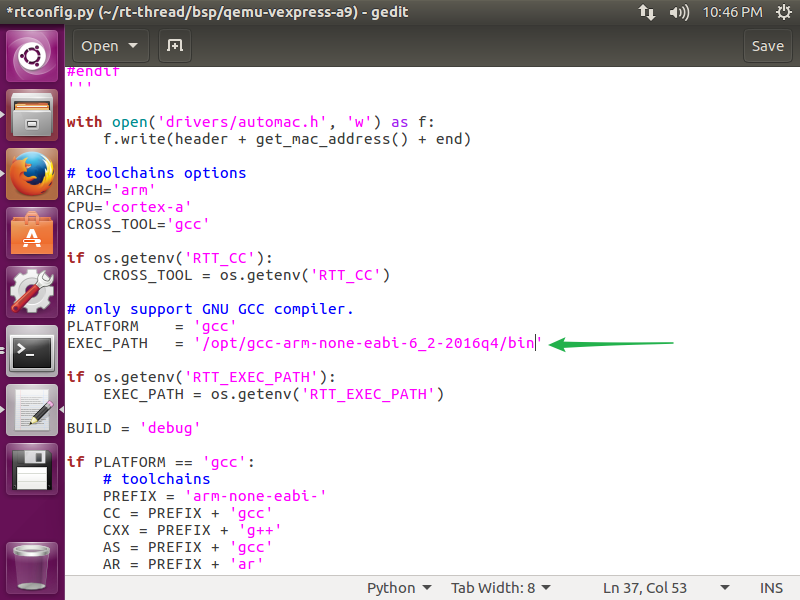
Instructions for the Env tool¶
Enter the BSP directory under the Linux terminal.
Install Env and Configure BSP¶
scons --menuconfig
The Env tool will be installed and initialized after using the scons --menuconfig command. Then it will enter the configuration interface, and you could configure the BSP:

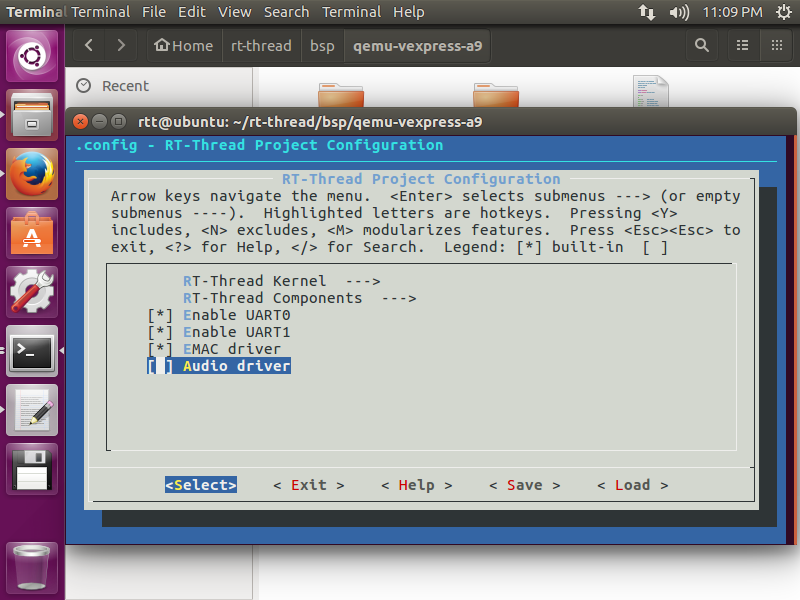
You can use the keyboard ↑ key and ↓ key to look up and down menu items, use the Enter key to enter the selected directory, use the Space key to select or cancel bool variables, and press Esc Esc to exit the current directory.
Acquisition of software packages¶
source ~/.env/env.sh sons --menuconfig pkgs --update
The env.sh file is a file that needs to be executed. It configures the environment variables so that we can update the package with the pkgs command and execute it with the source ~/.env/env.sh command.
Then use sons --menuconfig command to enter menuconfig, and you could select the online packages by this time.

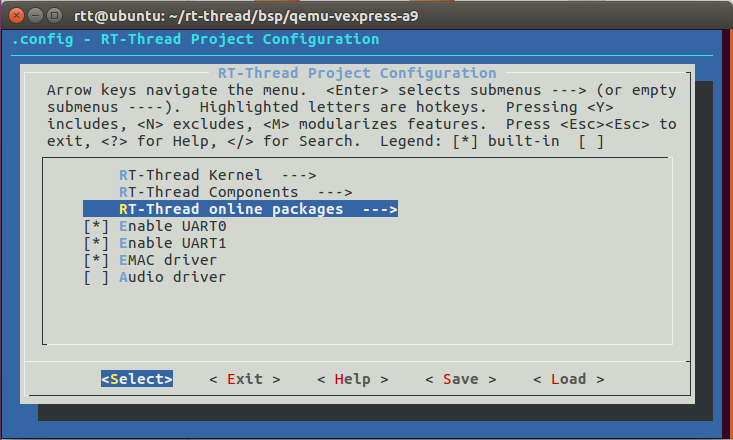
For example, select the kernel sample package: semphore sample.
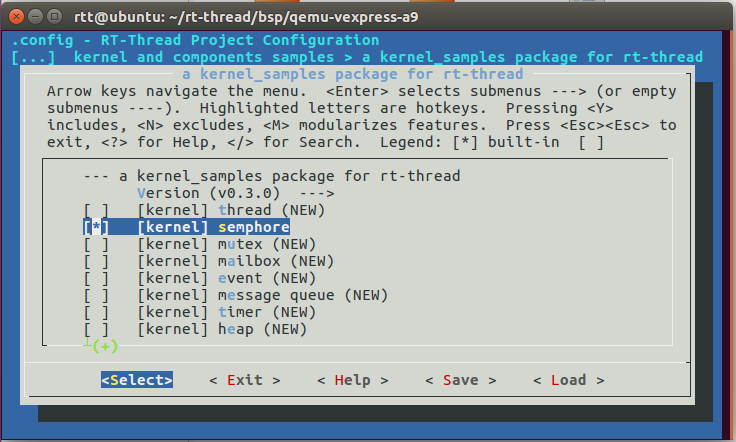
Exit and save the configuration.

If you have selected an online package, you can download the package to the packages folder in the BSP directory using the pkgs --update command (Git needs to be installed):

Compile¶
scons
Using the scons command to compile the BSP.
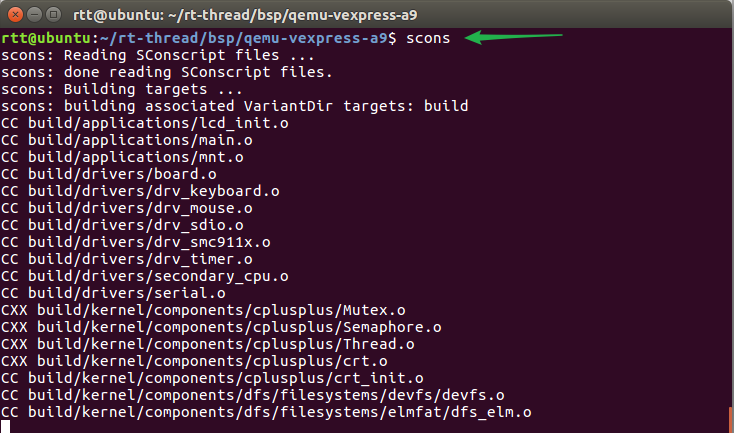
Introduction of QEMU BSP Catalogue¶
The board-level support package (BSP) provided by RT-Thread simulates ARM vexpress A9 development board is located in the qemu-vexpress-a9 folder under the bsp directory of RT-Thread source code. This BSP implements LCD, keyboard, mouse, SD card, Ethernet card, serial port and other related drivers. The contents of the folder are shown in the following figure.
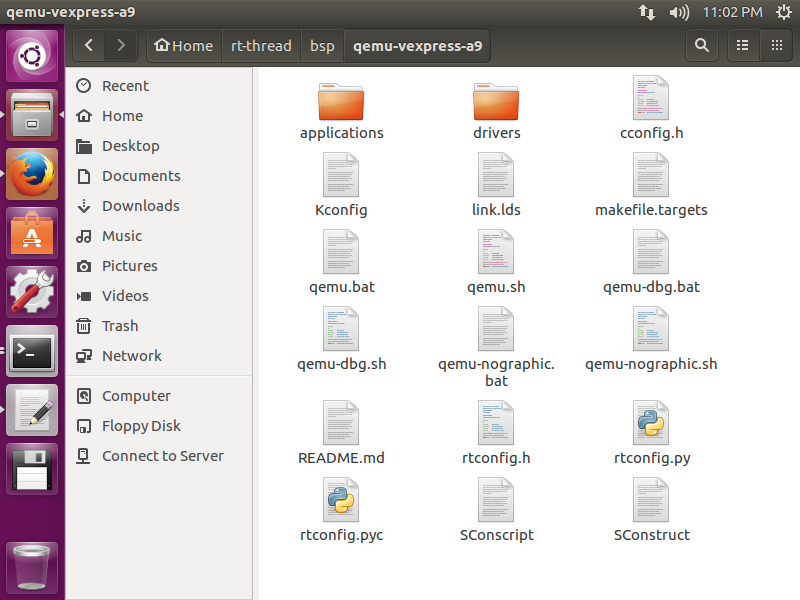
The main files and directories of qemu-vexpress-a9 BSP are described as follows:
| Files/Directories | Description |
|---|---|
| applications | User application code directory |
| drivers | The underlying driver provided by RT-Thread |
| qemu.bat | Script files running on Windows platform |
| qemu.sh | Script files running on Linux platform |
| qemu-dbg.bat | Debugging script files on Windows platform |
| qemu-dbg.sh | Debugging script files on Linux platform |
| README.md | Description document of BSP |
| rtconfig.h | A header file of BSP |
Compile and Run¶
Step 1. Use the scons Command to Compile the Project¶
Switch to the QEMU BSP directory and enter the scons command to compile the project. If the compilation is correct, the rtthread.elf file will be generated in the BSP directory, which is a target file required for QEMU to run.

Step 2. Use the ./qemu.sh Command to Run the Project¶
After compiling, type ./qemu.sh to start the virtual machine and BSP project. qemu.sh is a Linux batch file. This file is located in the BSP folder, mainly including the execution instructions of QEMU. The first run of the project will create a blank sd.bin file under the BSP folder, which is a virtual SD card with a size of 64M. The Env command interface displays the initialization information and version number information printed during the start-up of RT-Thread system, and the QEMU virtual machine is also running. As shown in the following picture:
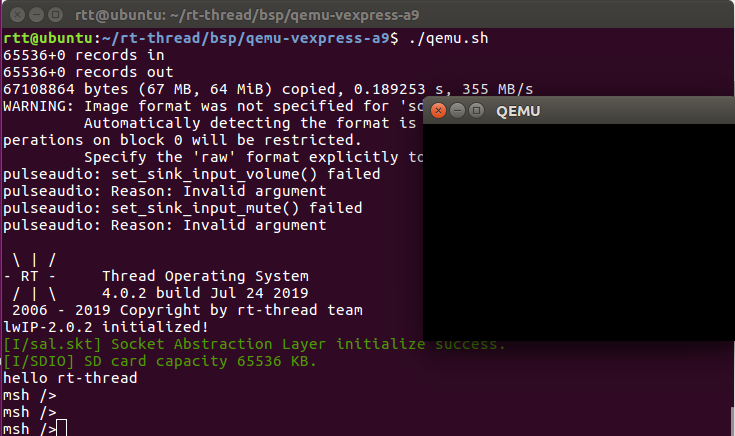
Run the Finsh Console¶
RT-Thread supports Finsh, and users can use command operations in command line mode.
Type help or press Tab to view all supported commands. As shown in the figure below, commands are on the left and command descriptions are on the right.
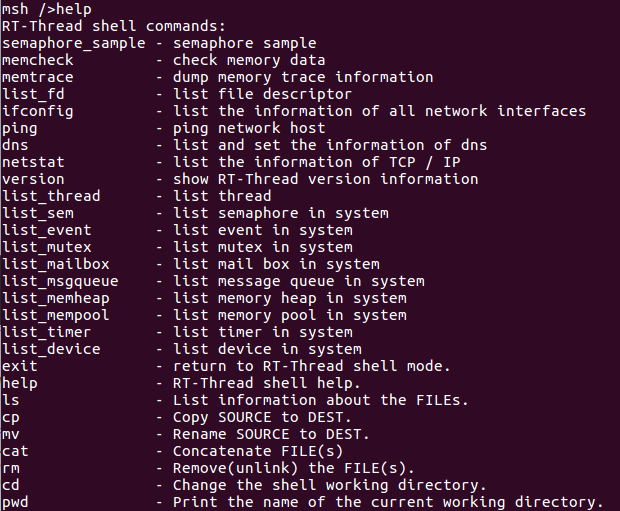
For example, by entering the list_thread command, you can see the currently running threads, thread status and stack size; by entering the list_timer, you can see the status of the timers.
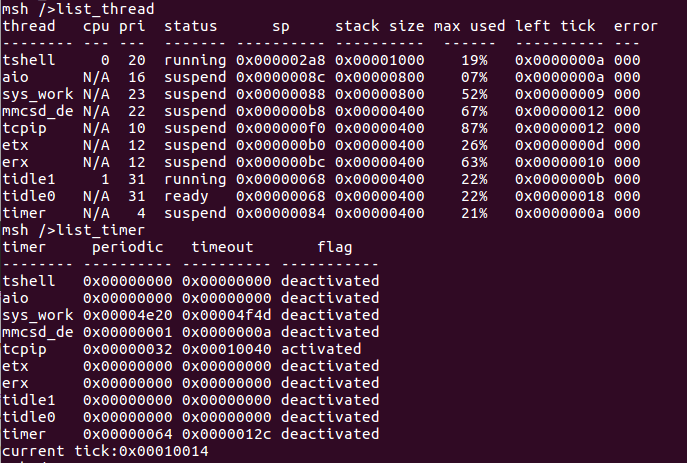
Run the File System¶
Type list_device to view all devices registered in the system. You can see the virtual SD card "sd0" device as shown in the following picture. Next, we can format the SD card using the mkfs sd0 command, which will format the SD card into a FatFS file system. FatFs is a Microsoft fat-compatible file system developed for small embedded devices. It is written in ANSI C, uses abstract hardware I/O layer and provides continuous maintenance, so it has good portability.
For more information on FatFS, click on the link: http://elm-chan.org/fsw/ff/00index_e.html
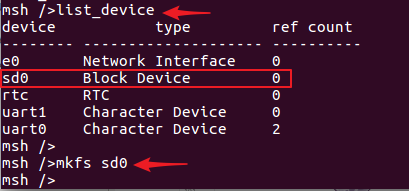
The file system will not be loaded immediately after the first formatting of the SD card, and the file system will be loaded correctly only after the second boot. So exit the virtual machine, and then restart the virtual machine and project by entering ./qemu.sh on the command line interface. Entering ls command, you can see that the Directory directory has been added, the file system has been loaded, and then you can experience the file system with other commands provided by RT-Thread:
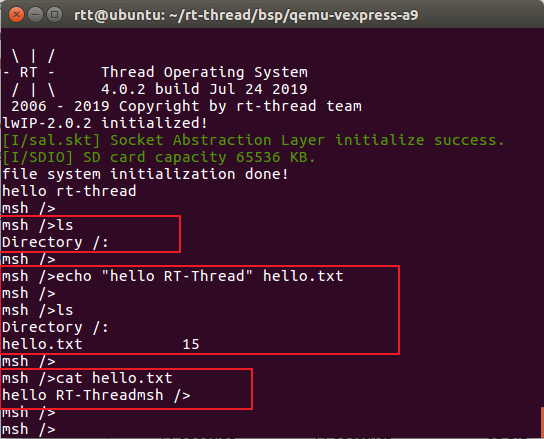
- ls: Display the file and directory information
- cd: Switch to the specified directory
- rm: Delete files or directories
- echo: Writes the specified content to the target file
- cat: Displays the details of a file
- mkdir: Create folders
Please enter help to see more commands.
More Functions¶
You can configure more functions in the menuconfig's configuration interface. use scons --menuconfig to config the BSP. After the configuration is completed, save the configuration first, and then exit the configuration interface, then:
- If you choose a package, you need to use the command
pkgs --updateto download the package. - Compile with
scons. - Then enter
./qemu.shto run QEMU. - Use
helpto view all commands of the BSP. And then use the commands.